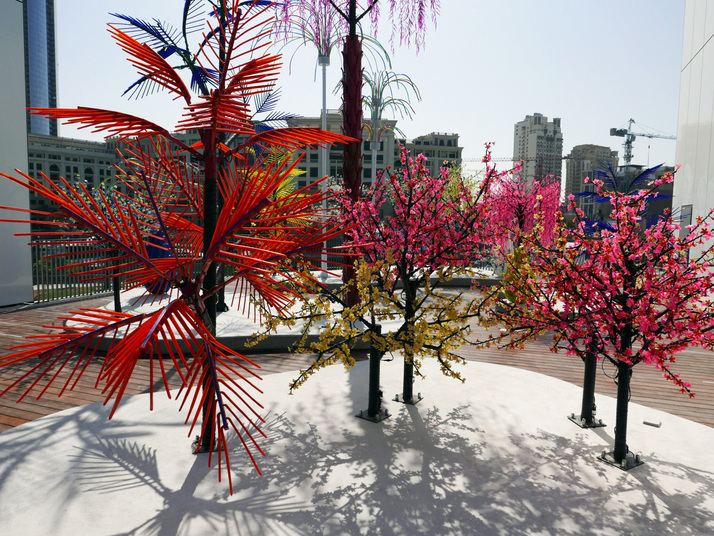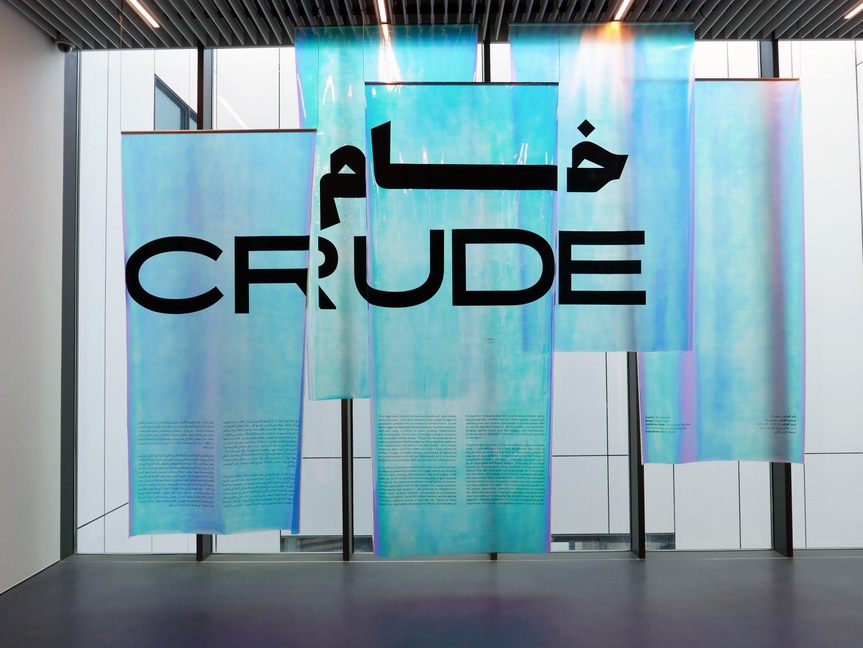
R
E
V N
E
X
T
Exterior of the Jameel Arts Centre, designed by Serie Architects, on the banks of the Dubai Creek, in the Al-Jaddaf district. All images taken by HG Masters for ArtAsiaPacific.
Thirty-three species of plants in the gardens; 3,000 books and materials in the library; four tons of rocks with twisted wire in Mohammed Ahmed Ibrahim’s sculpture; 2,500 meters of webbed red yarn in Chiharu Shiota’s sculpture: these were some of the numbers that Antonia Carver, the director of the newly opened Jameel Arts Centre, cited in her opening remarks to the press on November 11. The three-story, 10,000-square meter building sits on the waters of Dubai Creek, near the airport, in the Jaddaf waterfront district that is being developed by Dubai Holding. Designed by UK-based Serie Architects, the Centre is comprised of two clusters of white, aluminum-clad boxes, echoing the Gulf’s traditional sha’abi architecture, with desert gardens designed by landscape architect Anouk Vogel in the seven interspersed courtyards. The complex is bordered by the Jaddaf Waterfront Sculpture Park, designed by United Arab Emirates-based ibda design, and is located across a canal from the world’s only Versace hotel. The first morning the Centre was open to the public, it welcomed more than 300 schoolchildren.
Beyond the numbers, the real measure of Jameel Arts Centre will be the role it assumes in the cultural life of the UAE. As the first non-governmental contemporary art institution of its size, Jameel Arts Centre will, in Carver’s description, fill a gap between big institutions like the Louvre Abu Dhabi and Sharjah Art Foundation, and the commercial galleries of Alserkal Avenue in Dubai. It will be a kunsthalle-like venue for newly commissioned projects and exhibitions, alongside rotating showcases of works from the Art Jameel collection, as well as spaces like a library and co-working area that can host researchers, reading groups and public events. As Carver explained to me, her mandate from Art Jameel is to get diverse groups of people in the door, a mission that complements that of Community Jameel, a sister organization that promotes social development, job creation and poverty alleviation across the Middle East, North Africa and Turkey.
The Centre’s team has been doing outreach and experimental exhibitions for the past 18 months at its project space in Dubai’s Alserkal Avenue complex, with projects like “Research Studio: Confluence,” and they’ve already initiated or invited various reading groups to use their spaces. And, Carver said, there’s already been a huge demand. They could easily fill the space every day with bus tours on a tourism ministry-guided route, but instead they want to connect with local communities that don’t have places for their activities, like an Arabic poetry reading group that has been holding its meetings in a local coffee shop.
The ground floor galleries were occupied by a series of Artist’s Rooms, which largely feature works from the Art Jameel Collection. All of the rooms in the opening exhibition were by women artists: Maha Malluh showed an installation of pots, religious sermons on cassette tapes, and metal dishes; Mounira al-Solh had textile pieces relating to the experiences of Syria’s refugees; Lala Rukh was represented by paper-based works, “Mirror Image 1, 2, 3” (1997) and Heartscape (1997), and an animation based on classical South Asian musical compositions titled Rupak (2016); Chiharu Shiota’s Departure (2018) is a dhow enmeshed in a web of red wool that filled the gallery. In the lobby was Lara Favaretto and Shaikha al-Mazrou’s newly commissioned, minimalist installation of green-glass forms. Continuing the all-women programming, on the Roof Terrace was Alia Farid and Aseel al-Yaqoub’s Contrary Life: A Botanical Light Garden Devoted to Trees (2018), a forest of colorful plastic replicas of trees that light up at night because they are made from LEDs. They are based on actual artificial trees seen in the UAE and Kuwait, but custom manufactured in China. I can imagine property developers all around the world, from Florida to Foshan, lining up to take orders if they were ever mass-produced. Instead, they’ll be on view for a year, and like real plants will likely suffer under the Gulf’s extreme heat. Upstairs in the galleries, Jumana Manna’s feature-length film Wild Relatives (2018) captures the process of seeds from the Svalbard Global Seed Vault being planted in the wild in the Bekaa Valley after crops in Syria were threatened by the war.
Held concurrently during the Centre’s opening on the first floor was the exhibition “Crude,” with 17 artists’ works curated by Murtaza Vali. “Oil is magical and insidious,” proposes the introductory text—printed on hanging iridescent-blue sheets of plastic. The show began with the insidious, focusing on the region’s modernization and destruction by the global forces of petro-politics. Handsome black-and-white photographs by Latif al-Ani capture Baghdad’s midcentury transformation, while Rayyane Tabet’s sculpture Steel Rings (2013) comprises metal rings replicating the Trans-Arabian pipeline that spanned eastern Saudi Arabia to Sidon on the Lebanese coast (and was shown in a larger scale in the 2015 Sharjah Biennial). Hajra Waheed’s Plume 1-24 (2017), a collage series using images of billowing smoke, evokes the burning oil fields of Kuwait following the end of the Gulf War (1990–91), while Monira al-Qadiri’s video Behind the Sun (2013) pairs actual footage of the events with apocalyptic narration of Sufi poetry taken from Kuwait television. From historical beginnings, the show turned toward contemporary petro-culture, and the magical sheen and properties of the black gold. Al-Qadiri’s iridescent sculpture of a drill bit levitates above a plinth. Michael John Whelan’s glass versions of Jacques Cousteau’s “Aqua Lungs” are made from sand taken from the waters off the coast of the UAE, and recall the breathing apparatus that made underwater exploration for oil possible—especially crucial to Abu Dhabi’s history. In the subsequent room, oil “magically” adopts properties completely the opposite of its original, opaque liquid state. Hassan Sharif’s pile of wire-bound flip-flops and Raja’a Khalid’s artfully draped fluorescent-green car cover are both part-minimalist sculpture, part-ironic paean to the UAE’s consumer-automotive petro-fueled society. As Vali pointed out, even if humanity can wean itself off of oil as an energy source, it’s hard to imagine a world without plastic.
In the last decade, it seems that nearly every institution, project or major exhibition about art from West Asia and North Africa has found itself at some point caught up in a controversy born of regional politics—particularly in the UAE, where traditional societal and legal structures clash with international norms of individual and workers’ rights (as in the case of Gulf Labor’s campaign against Guggenheim Abu Dhabi). The Jameel Arts Centre is no exception. Recent events in Saudi Arabia have brought attention to the country’s ruling families and elites, as crown prince Mohammed Bin Salman consolidates power, and many other prominent figures have fallen from grace, been imprisoned, and in the case of political commentator and advisor Jamal Khashoggi, lost their lives. The Jameel family’s businesses and social projects are based in Saudi Arabia, and Art Jameel is planning to open a creative space in Jeddah in 2019. If there is an almost paranoid level of sensitivity and fear around what is happening in the orbit of Saudi society, including among those who live in the UAE, at Jameel Arts Centre’s opening there was also a clear emphasis on putting forward the art, the institution and the communities it hopes to reach. The test will be in time, as foot traffic grows, groups begin to inhabit the spaces, the restaurant opens, the neighborhood is populated, and the silent veneer of a new space becomes a steady hum of activity.
“Crude” is on view at the Jameel Arts Centre, Dubai, until March 30, 2019. There will be a full review of the show in AAP 112 (Mar/Apr 2019).













